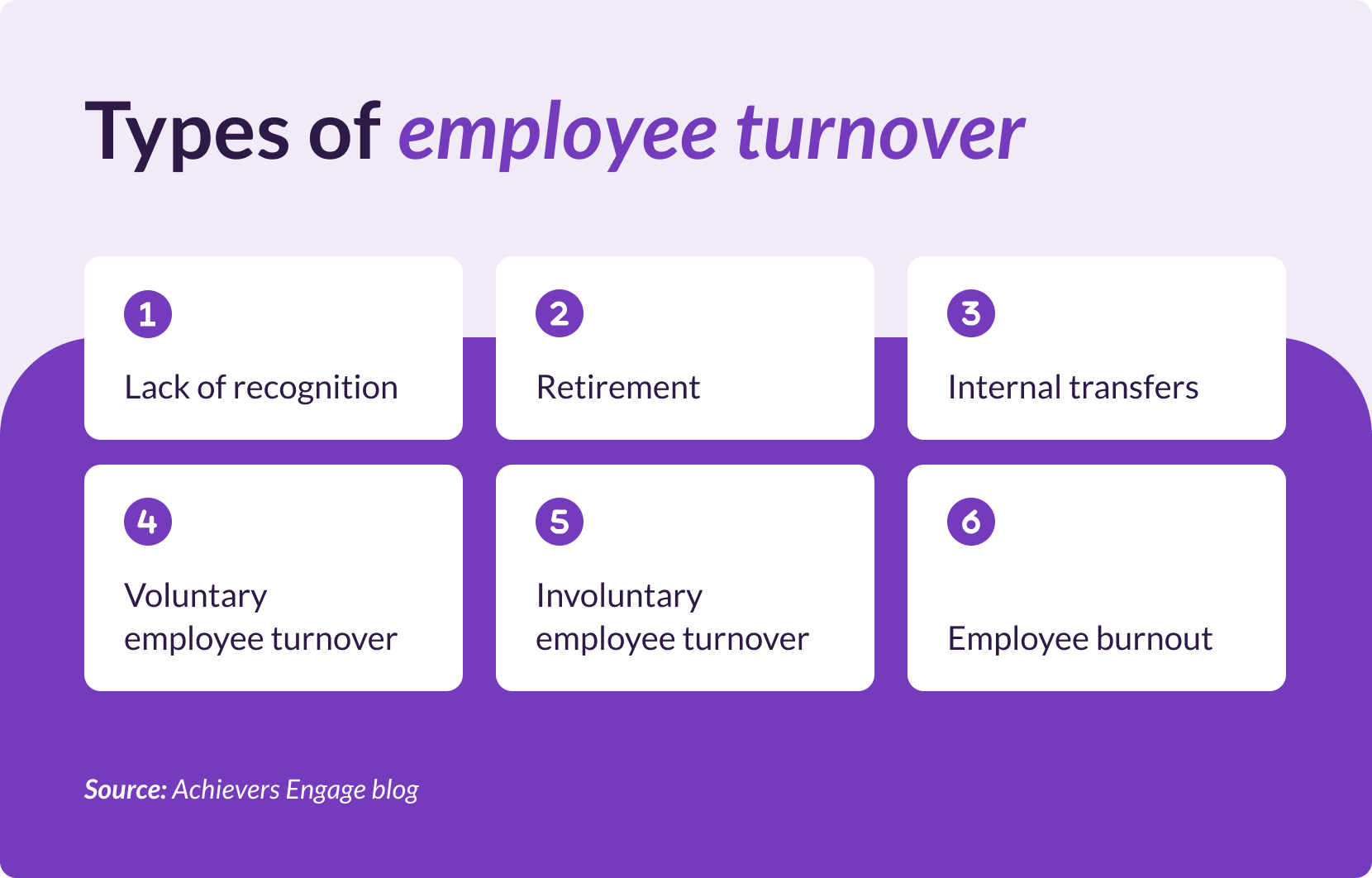Table of contents
Employee turnover is a major challenge for companies, driven by unprecedented mobility, talent shortages, lack of clarity around why employees leave – leading to insufficient retention strategies.
Research indicates that 30% of new hires exit their roles within the first three months, with 43% leaving because of mismatched expectations, and 32% citing poor cultural fit as the main factor.
However, by understanding the root causes of turnover and adapting to the constantly changing workforce landscape, organizations can strengthen their teams while cultivating company culture that fosters loyalty and job satisfaction.
What is employee turnover?
Employee turnover is the departure of employees from your company, whether by choice or due to termination. This includes layoffs, resignations, and terminations. A primary concern for organizations is voluntary turnover, where employees choose to resign. Understanding its underlying causes is crucial, as this is often why companies lose talented, high-performing employees.
In addition to losing the talent your company has invested time and money into acquiring and training, there’s also the added expense of recruiting and onboarding new hires. This is why understanding and reducing employee turnover should be a top priority for organizations.
What causes employee turnover?
- Management problems: The saying that “people don’t leave companies, they leave managers” is often accurate. Poor leadership can lead to low morale and disengagement – motivating employees to look elsewhere.
- Poor work-life balance: When the boundaries between work and life are blurred and employee wellbeing is not a priority, people may leave in search of better balance and opportunities to tend to their mental health.
- Lack of recognition: Employees that don’t feel acknowledged or valued for their contributions are less likely to stay in their current roles. Recognition is key to maintaining healthy expectations while also boosting morale.
- Burnout: A lack of work-life balance can lead to the overworked employee feeling chronically stressed, exhausted, and eventually leaving their jobs.
- Lack of career advancement: If there isn’t a clear path for advancement within the organization or access to mentorship, employees with career aspirations may leave for companies that provide these opportunities.
- Not enough flexibility: Employees that have access to flexible work arrangements feel a sense of autonomy and agency and are less likely to job hunt.
- Boredom: Monotonous, purposeless, and unchallenging tasks can lead to disengagement, prompting employees to seek more stimulating roles elsewhere.
- Uncomfortable work environments: Workplace conditions that make employees feel uncomfortable, whether it’s due to lack of psychological safety, job insecurity, or misalignment with company culture – could be a catalyst for turnover.
- Low pay: If compensation doesn’t align with an employee’s level of experience or the workload required, they may seek employment elsewhere.
What is the cost of employee turnover?
Employee turnover can be surprisingly costly for organizations, impacting finances, productivity, and morale. According to Gallup, the cost of replacing an employee is dependent on the role, roughly 200% of a manager’s salary, 80% for technical roles, and 40% for frontline employees.
Employee turnover can affect multiple areas of the hiring process and employee wellbeing, potentially leading to significant costs for the company. It includes:
- The recruitment process: There are several costs associated with the hiring process, including advertising the position, diverting interviewers from their primary work responsibilities, or additional background check expenses.
- Onboarding: Bringing a new employee up to speed could take weeks or months. During the onboarding period, employers should expect lower productivity, as new hires get comfortable in their new role and work environment.
- Employee morale or engagement: Recruiters and interviewers aren’t the only ones impacted by turnover. Employees that witness high rates of employee turnover are likely to feel disengaged and confused — impacting morale.
- Possibility of burnout: When an employee leaves the company, their tasks may be redistributed to their colleagues, which can lead to increased stress and burnout.
How do you calculate employee turnover?
Divide the number of employees that have left your company over a period (monthly or annually) by the average number of employees during that period. Then, multiply the result by 100 to get your employee turnover rate percentage.
The formula to calculate your turnover percentage is:
Annual turnover = [(number of employees who left / average number of employees) * 100]
For example, if 5 employees left during the year and the average number of employees was 80, the turnover rate would be:
(5 / 80) * 100 = 6.25%
12 types of employee turnover and how to address them
The drivers of employee turnover vary from organization to organization — which is why frequently collecting employee feedback is so important — but there are some common causes that have an outsize impact. Here are six major drivers, together with strategies you can employ for each.
1. Not enough recognition
Employees who give their all day-in, day-out but rarely or never receive thanks for their efforts aren’t likely to stay with their employer for long. No matter what financial compensation or benefits they receive, a lack of recognition leads to disengagement, a lack of satisfaction, and, ultimately, higher turnover. A real culture of recognition isn’t defined by the number of times a manager says “thank you” — although frequent recognition is important — or the monetary value of rewards given out. Instead, it relies on genuine, specific appreciation that calls out the behavior being recognized and is personalized for the recipient.
Encouraging this approach to recognition across your organization is much simpler with an employee recognition program. Whether it’s congratulating a coworker on a personal milestone while working remotely or receiving a batch of reward points you can redeem for a huge range of things you actually want, technology enables effective recognition in the modern workplace.
2. Failure to listen
Every employee has ideas about how their organization could be improved, whether it’s encouraging a different management style or focusing more on employee wellness. But finding team members who are comfortable sharing input honestly is less common, often because leaders appear to disregard their feedback whenever they provide it. If management and HR don’t listen closely when employees speak — or if they fail to act quickly in response to the feedback — team members are likely to feel they don’t have a real voice at the company. If your enterprise doesn’t seem to value their input, why wouldn’t they find a company that will?
The first step to combatting this problem is training leadership on why and how to listen to employee feedback. Once your organization has laid this foundation, it’s time to build easy-to-use, always-on channels for employee feedback, so team members don’t have to rely on catching their manager at the right time or scheduling a meeting with HR. Look to an employee engagement platform with tools for regularly taking the pulse of employees across your company and guiding managers as they build collaborative action plans with their teams.
3. Lack of cultural alignment
Company culture is the bedrock of organizational success, and few things drive employees away more quickly than a culture that doesn’t meet their expectations. Cultural alignment starts with hiring employees who actually match the type of organization you want to build, rather than simply checking off boxes in terms of skills and experience. Developing cultural alignment continues beyond the hiring and onboarding process with continually recognizing positive employee behavior and working to change aspects of your culture that don’t align with your company vision or your organization’s core values.
4. Poor leadership
Poor leadership can be the result of individual actions or problems endemic to your company culture. Hiring empathetic leaders who know to coach rather than micromanage is crucial to improving all employee retention. A good leader should also seek out constructive criticism and hold themselves accountable to that feedback. And they should serve as examples for the entire company, especially when it comes to showing appreciation and establishing a sense of belonging for all employees.
5. Burnout
Many employees experience burnout at one time or another, but it should remain the exception rather than the norm. If work-life balance is skewed too much to the former and there’s no relief in sight, team members are bound to seek relief by moving to another company — or by simply quitting and figuring the rest out later. Prioritizing employee wellness with strategic initiatives, offering flexibility in when and where employees work, and ensuring team members’ workloads are appropriate are some of the most effective ways to combat burnout.
6. Lack of career advancement
You wouldn’t hire an employee that didn’t have the drive to grow. So why would a motivated employee want to stay with a company that doesn’t provide opportunities for growth? If you want to keep strong employees at your company, you must give them opportunities for professional development. Take a broad approach to talent development and address everything from establishing clear paths for career advancement to offering continuing education reimbursement and establishing in-house training opportunities. This last option is easier than it may seem thanks to online course offerings and the ability to easily customize and administer learning programs with modern training solutions.
7. Voluntary employee turnover
Voluntary employee turnover occurs when employees leave an organization for a variety of reasons, whether for a new role, personal reasons, to go back to school, or to pursue life interests such as traveling. Unlike involuntary turnover, which is a decision made on the employer’s side, voluntary turnover is generally more disruptive and costly as it may involve the loss of high-performing employees.
Some strategies HR professionals can use to minimize voluntary turnover:
- Offer competitive compensation
- Foster a supportive work environment
- Provide mentoring and career development
- Encourage work-life balance
8. Involuntary employee turnover
As mentioned in the above section, involuntary turnover happens when a company chooses to terminate an employee’s employment. Typically, this decision is made due to lackluster performance, behavioral issues, or simply a mismatch between the employee and company culture or what is expected from the role.
To reduce involuntary turnover, companies should enhance their hiring practices and implement regular performance evaluations. Additionally, employers can adopt a more supportive approach by offering training and development programs. These measures not only help employees align better with their roles but also set them up for long-term success.
9. Retirement
Unlike other forms of employee turnover, retirement is typically something employers can anticipate and plan for. It marks a significant life transition for the employee as they permanently exit the workforce. Although retirement is a natural stage in an employee’s career, it can still present challenges for companies, particularly in knowledge transfer and succession planning. Planning for an employee’s retirement can also involve offering flexible retirement options, allowing the employee to transition gradually by staying on part-time while helping to train their replacement.
10. Internal transfer
Internal transfers are a form of employee turnover where employees transition to different roles within the same organization. Internal transfers are generally considered positive, as they highlight the company’s commitment to offering career advancement opportunities and promotions from within. However, sometimes internal transfers are less positive as it could be initiated by an employee wanting to escape from a toxic team environment, poor management, or overall dissatisfaction with their role.
To address any challenges associated with internal transfers, HR professionals could:
- Regularly review compensation and role expectations and assess how aligned they are with employee needs
- Improve management practices and foster a positive work environment
11. Functional employee turnover
Functional employee turnover is when an employee’s departure is actually beneficial to the organization. This type of turnover typically occurs when the employee is culturally mismatched or underperforming, and the turnover is either voluntary or involuntary. Unlike dysfunctional turnover, which will be covered in the next section, where the loss of top performers could be harmful to the organization – functional turnover could make space for employees that are better suited to the role.
To manage functional turnover, organizations can take several steps. Regular performance evaluations help monitor employee progress, while clear communication of role expectations ensures everyone is on the same page. Additionally, updating hiring practices can increase the likelihood of finding employees who are well-aligned with their roles. Finally, HR professionals should also conduct thorough exit interviews to understand the underlying reasons for the departures.
12. Dysfunctional employee turnover
Dysfunctional turnover is when top performers or key employees leave the company. This type of turnover usually has a negative business impact, as it leads to the loss of valuable knowledge and skills that are hard to replace. Dysfunctional turnover can disrupt morale, team dynamics, and productivity, creating a ripple effect that may cause other employees to consider leaving.
To address dysfunctional turnover, organizations can do the following:
- Provide competitive compensation and benefits
- Offer mentorship and career growth opportunities
- Give regular feedback, support, and recognition
- Communicate openly to address job dissatisfaction early on

Reduce employee turnover with Achievers
If employee turnover at your organization is higher than you’d like, there’s hope for improvement. The Achievers Engagement Platform is your ticket to developing a culture that helps attract the best talent and ensure they want to stay for the long haul. It’s powered by Achievers Recognize and our voice of employee solution, which enable a one-two punch of organization-wide, fun recognition and increased employee engagement that will serve as your company’s most powerful tool for boosting retention.


